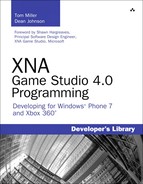Contents
So You Want to be a Game Developer?
A Brief History of XNA Game Studio
What Is Available in Game Studio 4.0?
Installing XNA Game Studio 4.0
Your First XNA Game Studio Windows Game
Your First XNA Game Studio XNA Xbox 360 Game
Your First XNA Game Studio Windows Phone 7 Game
3. The Game Object and the Default Game Loop
4. Introduction to 3D Graphics
3D Graphics in XNA Game Studio
Reach and HiDef Graphics Profiles
Graphics Profiles Define Platform Capabilities
Textures, Vertex Colors, and Fog
7. States, Blending, and Textures
Faking a Shadow with a Depth Buffer and Render Targets
8. Introduction to Custom Effects
Creating Your First Custom Effect
Setting Sampler States in Effect File
Alpha Blending Using Effect States
Tracing Content Through the Build System
Combining It All and Building Assets
Combining What You Learned So Far
Accessing Avatar Information Using AvatarDescription
Loading Avatar Animations with AvatarAnimation
Drawing the Avatar Using AvatarRenderer
2D Avatars Using Render Targets
Building the Custom Animation Type
Creating the Content Processor
Adding the Custom Animation to Your Game
Updating Your Game to Use the Custom Animation
12. Adding Interactivity with User Input
Using Input in XNA Game Studio
Polling versus Event-Based Input
Moving Sprite Based on Keyboard Input
Moving Sprite Based on Mouse Input
Moving Sprites Based on Gamepad Input
Multitouch Input For Windows Phones
Reading the TouchPanel Device State
Determine Number of Touch Points
TouchPanel Width, Height, and Orientation
Moving Sprite Based on Multitouch Input
Reading Gestures from the TouchPanel
Windows Phone Sensors and Feedback
Acceleration Data using the Accelerometer
Locating a Windows Phone with the Location Service
Providing User Feedback using Vibration
Using SoundEffect for Audio Playback
Microsoft Cross-Platform Audio Creations Tool (XACT)
Recording Audio with a Microphone
Generating Dynamic Sound Effects
The IsolatedStorageFile Object
Recreating the Project on Xbox
Loading Loose Files from Your Project
Platform-Specific Guide Functionality
Getting Ready for Networking Development
Main Menu and State Management
Searching for an Available Network Session
Joining an Available Network Session
Simulating Real World Network Conditions
17. Using Media in XNA Game Studio
B. Using the Windows Phone FMRadio
